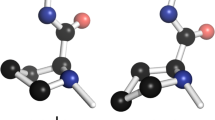Abstract
Periostin, an extracellular matrix protein, is secreted by fibroblasts and is overexpressed in various types of cancers. The four internal repeat fasciclin 1 (FAS1) domains of human periostin play crucial roles in promoting tumor metastasis and progression via interaction with cell surface integrins. Among four FAS1 domains of human periostin, the fourth FAS1 domain (FAS1-IV) was prepared for NMR study, since only FAS1-IV was highly soluble, and showed a well-dispersed 2D 1H-15N HSQC spectrum. Here, we report nearly complete backbone and side chain resonance assignments and a secondary structural analysis of the FAS1-IV domain as first steps toward the structure determination of FAS1-IV of human periostin.


Similar content being viewed by others
References
Bax A, Clore GM, Gronenborn AM (1990) 1H-1H correlation via isotropic mixing of 13C magnetization, a new three-dimensional approach for assigning 1H and 13C spectra of 13C-enriched proteins. J Magn Reson 88:425–431
Bruder SP, Ricalton NS, Boynton RE, Connolly TJ, Jaiswal N, Zaia J, Barry FP (1998) Mesenchymal stem cell surface antigen SB-10 corresponds to activated leukocyte cell adhesion molecule and is involved in osteogenic differentiation. J Bone Min Res 13:655–663. doi:10.1359/jbmr.1998.13.4.655
Coutu DL, Wu JH, Monette A, Rivard GE, Blostein MD, Galipeau J (2008) Periostin, a member of a novel family of vitamin K-dependent proteins, is expressed by mesenchymal stromal cells. J Biol Chem 283:17991–18001. doi:10.1074/jbc.M708029200
Delaglio F, Grzesiek S, Vuister GW, Zhu G, Pfeifer J, Bax A (1995) NMRPipe: a multidimensional spectral processing system based on UNIX pipes. J Biomol NMR 6:277–293
Doliana R, Bot S, Bonaldo P, Colombatti A (2000) EMI, a novel cysteine-rich domain of EMILINs and other extracellular proteins, interacts with the gC1q domains and participates in multimerization. FEBS Lett 484:164–168
Ghatak S et al (2014) Periostin induces intracellular cross-talk between kinases and hyaluronan in atrioventricular valvulogenesis. J Biol Chem 289:8545–8561. doi:10.1074/jbc.M113.539882
Grzesiek S, Bax A (1992) Improved 3D triple-resonance NMR techniques applied to a 31 kDa protein. J Magn Reson 96:432–440
Hoersch S, Andrade-Navarro MA (2010) Periostin shows increased evolutionary plasticity in its alternatively spliced region. BMC Evol Biol 10:30. doi:10.1186/1471-2148-10-30
Horiuchi K et al (1999) Identification and characterization of a novel protein, periostin, with restricted expression to periosteum and periodontal ligament and increased expression by transforming growth factor beta. J Bone Min Res 14:1239–1249. doi:10.1359/jbmr.1999.14.7.1239
Johnson BA, Blevins RA (1994) NMR View: A computer program for the visualization and analysis of NMR data. J Biomol NMR 5:603–614
Kay LE, Ikura M, Tschudin R, Bax A (1990) Three-dimensional triple-resonance NMR spectroscopy of isotopically enriched proteins vol 89. J Magn Reson. doi:10.1016/0022-2364(90)90333-5
Kudo A (2011) Periostin in fibrillogenesis for tissue regeneration: periostin actions inside and outside the cell. Cell Mol Life Sci 68:3201–3207. doi:10.1007/s00018-011-0784-5
Li W, Gao P, Zhi Y, Xu W, Wu Y, Yin J, Zhang J (2015) Periostin: its role in asthma and its potential as a diagnostic or therapeutic target. Respir Res 16:57. doi:10.1186/s12931-015-0218-2
Litvin J, Zhu S, Norris R, Markwald R (2005) Periostin family of proteins: therapeutic targets for heart disease. Anat Rec 287:1205–1212. doi:10.1002/ar.a.20237
Marion D, Driscoll PC, Kay LE, Wingfield PT, Bax A, Gronenborn AM, Clore GM (1989) Overcoming the overlap problem in the assignment of 1H NMR spectra of larger proteins by use of three-dimensional heteronuclear 1H-15N Hartmann-Hahn-multiple quantum coherence and nuclear Overhauser-multiple quantum coherence spectroscopy: application to interleukin 1 beta. Biochemistry 28:6150–6156
Masuoka M et al (2012) Periostin promotes chronic allergic inflammation in response to Th2 cytokines. J Clin Invest 122:2590–2600. doi:10.1172/JCI58978
Morra L, Moch H (2011) Periostin expression and epithelial-mesenchymal transition in cancer: a review and an update. Virchows Arch 459:465–475. doi:10.1007/s00428-011-1151-5
Palmer AG, Cavanagh J, Wright PE, Rance M (1991) Sensitivity improvement in proton-detected two-dimensional heteronuclear correlation NMR spectroscopy. J Magn Reson 93:151–170. doi:10.1016/0022-2364(91)90036-S
Shen Y, Bax A (2013) Protein backbone and sidechain torsion angles predicted from NMR chemical shifts using artificial neural networks. J Biomol NMR 56:227–241. doi:10.1007/s10858-013-9741-y
Suzuki H et al (2004) Immunohistochemical localization of periostin in tooth and its surrounding tissues in mouse mandibles during development. Anat Rec 281:1264–1275. doi:10.1002/ar.a.20080
Tai IT, Dai M, Chen LB (2005) Periostin induction in tumor cell line explants and inhibition of in vitro cell growth by anti-periostin antibodies. Carcinogenesis 26:908–915. doi:10.1093/carcin/bgi034
Takeshita S, Kikuno R, Tezuka K, Amann E (1993) Osteoblast-specific factor 2: cloning of a putative bone adhesion protein with homology with the insect protein fasciclin I. Biochem J 294(Pt 1):271–278
Wittekind M, Mueller L (1993) HNCACB, a high-sensititity 3D NMR experiment to correlate amide-proton and nitrogen resonances with the alpha- and beta-carbon resonaces in proteins. J Magn Reson 101:201–205
Yun H, Kim JI, Lee CW (2016) Expression and preparation of periostin FAS1 domains for NMR structure determination vol 20. J Korean Magn Reson Soc. doi:10.6564/JKMRS.2016.20.1.017
Zuiderweg ER, Fesik SW (1989) Heteronuclear three-dimensional NMR spectroscopy of the inflammatory protein C5a. Biochemistry 28:2387–2391
Acknowledgements
We would like to thank the Basic Science Research Institute at Ochang, Korea, for performing the high-field NMR experiments. This work was supported by the Basic Science Research Program through the National Research Foundation of Korea (NRF) funded by the Ministry of Education, Science, and Technology of Korea (NRF-2013R1A1A2009419 to C.W.L).
Author information
Authors and Affiliations
Corresponding author
Rights and permissions
About this article
Cite this article
Yun, H., Kim, EH. & Lee, C.W. 1H, 13C, and 15N resonance assignments of FAS1-IV domain of human periostin, a component of extracellular matrix proteins. Biomol NMR Assign 12, 95–98 (2018). https://doi.org/10.1007/s12104-017-9786-z
Received:
Accepted:
Published:
Issue Date:
DOI: https://doi.org/10.1007/s12104-017-9786-z




